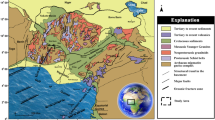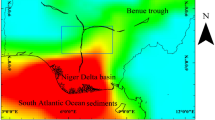Abstract
High-resolution aeromagnetic and Landsat-8 data were utilized for the structural investigation of the Igarra Schist Belt located where the Precambrian crystalline basement is unconformably overlain by the late-Cretaceous Anambra Basin fill. Analysis of the Landsat-8 data exhibits major lineaments that trend in E–W, ENE–WSW, NNW–SSE and N–S directions. Results from the analysis of total field anomaly data using total gradient amplitude and tilt angle of the horizontal gradient also show these same lineament trends. The superimposition of Landsat-8 and aeromagnetic data-derived lineaments resulted in the mapping of the regional lineaments, which provide clues to structurally controlled gold mineralization in the Igarra Schist Belt region. Details mapped from the remote sensing data show surface contacts that correspond to the boundary between the Igarra Schist Belt and Anambra Basin mapped from aeromagnetic data. The source parameter imaging of the aeromagnetic data provides depth estimates of the magnetic basement of the Igarra Schist Belt and Anambra Basin, which varies from 50 to above 650 m. The integration of the remote sensing and aeromagnetic lineaments with the 3-D Euler deconvolution results reveals that the locations of cluster solutions alignment with lineaments are target areas for gold mineralization, which is correlative to gold occurrences in the region.













Similar content being viewed by others
Data availability
The Landsat 8 OLI/TIRS data used for this study are publicly accessible and can be downloaded from the US Geological Survey (USGS) website. However, the high-resolution aeromagnetic data are not publicly available, but can be acquired from the Nigeria Geological Survey Agency.
References
Adebayo OF, Adegoke AK, Mustapha KA, Adeleye MA, Agbaji AO, Abidin NSZ (2018) Paleoenvironmental reconstruction and hydrocarbon potentials of upper cretaceous sediments in the Anambra Basin, southeastern Nigeria. Int J Coal Geol 192:56–72. https://doi.org/10.1016/j.coal.2018.04.007
Agustina P, Mario EG, Guido MG, Andrés F, Patricia M (2019) Magnetic characterization of a retroarc extensional basin: The Loncopué Trough. J South Am Earth Sci 89:55–62
Ajibade AC, Woakes M, Rahaman MA (1987) Proterozoic crustal development in the pan African regime of Nigeria. In: Kröner A (ed) Proterozoic lithospheric evolution. American Geophysical Union, Geodynamic Series, Vol 17. pp 259–271
Alavi PS (2003) Application of remote sensing in geology (earth sciences), vol 1. University of Tehran, Tehran
Andongma WT, Gajere JN, Amuda AK, Edmond RRD, Faisal M, Yusuf YD (2020) Mapping of hydrothermal alterations related to gold mineralization within parts of the Malumfashi Schist belt, North-Western Nigeria. Egypt J Remote Sens Space Sci. https://doi.org/10.1016/j.ejrs.2020.11.001
Caxito F, Santos LCM, Ganade CE, Bendaoud A, Fettous E, Bouyo MH (2020) Toward an integrated model of geological evolution for NE Brazil–NW Africa: the Borborema Province and its connections to the Trans-Saharan (Benino-Nigerian and Tuareg shields) and Central African orogens. Braz J Geol 50(2):e20190122
Cordell L, and Grauch VJS (1985) Mapping basement magnetization zones from aeromagnetic data in the San Juan Basin, New Mexico, In: Hinze WJ, ed., The utility of regional gravity and magnetic anomalies maps: SEG, 181–197
Dada SS (1998) Crust-forming ages and Proterozoic crustal evolution in Nigeria: a reappraisal of current interpretations. Precambrian Res 87(1–2):65–74. https://doi.org/10.1016/S0301-9268(97)00054-5
Dada SS (2008) Proterozoic evolution of the Nigeria–Boborema province. In: Pankhurst RJ, Trouw RAJ, de Brito Neves BB, de Wit MJ (eds) West Gondwana: pre-cenozoic correlations across the south Atlantic region. Geological Society, London, Special Publications 294: 121–136. https://doi.org/10.1144/sp294.7
Eldosouky AM, Pham LT, Mohammed H, Pradhan B (2020) A comparative study of THG, AS, TA, Theta, TDX and LTHG techniques for improving source boundaries detection of magnetic data using synthetic models: a case study from G. Um Monqul, North Eastern Desert, Egypt. J Afr Earth Sci 170:103940. https://doi.org/10.1016/j.jafrearsci.2020.103940
Eldosouky AM, Elkhateeb SO, Mahdy AM, Saad AA, Fnais MS, Abdelrahman K, Andráš P (2022) Structural analysis and basement topography of Gabal Shilman area, South Eastern Desert of Egypt, using aeromagnetic data. J King Saud Univ Sci 34:101764. https://doi.org/10.1016/j.jksus.2021.101764
Fagbohun BJ, Omitogun AA, Bamisaiye OA, Ayoola FJ (2020) Remote detection and interpretation of structural style of the Zuru Schist belt, Northwest Nigeria. Geocarto Int. https://doi.org/10.1080/10106049.2020.1753822
Ferreira FJF, Souza J, Bongiolo ABS, Castro LG (2013) Enhancement of the total horizontal gradient of magnetic anomalies using the tilt angle. Geophysics 78(3):33–41. https://doi.org/10.1190/geo2011-0441.1
Garba I (2003) Geochemical characteristics of mesothermal gold mineralisation in the Pan African (600 ± 150 Ma) basement of Nigeria. Appl Earth Sci 112:319–325. https://doi.org/10.1179/037174503225003143
Groves DI, Goldfarb RJ, Robert F, Hart CJR (2003) Gold deposits in metamorphic belts: overview of current understanding, outstanding problems, future research, and exploration significance. Econ Geol 98(1):1–29. https://doi.org/10.2113/gsecongeo.98.1.1
McCurry P (1978) Geology of degree sheets 19 (Zuru), 20 (Chafe), and part of 19 (Katsina). Overseas Geological Mineral Resource, Nigeria, p 53
Nabighian MN (1972) The analytic signal of two-dimensional magnetic bodies with polygonal cross-section: Its properties and use for automated anomaly interpretation. Geophysics 37:507–517
Nabighian MN (1974) Additional comments on the analytic signal of two dimensional magnetic bodies with polygonal cross-section. Geophysics 39:85–92
Nabighian MN (1984) Toward a three-dimensional automatic interpretation of potential field data via generalized Hilbert transforms: fundamental relations. Geophysics 49:780–786
Nigerian Geological Survey Agency (NGSA) Mineral resources map of Nigeria (2006)
Nigerian Geological Survey Agency (NGSA) (2011) Regional geology map of Lokoja and surroundings. Map prepared by NGSA. 31, Shetima Mangono Crescent Utako District, Garki, Abuja
Oden MI, Udinmwen E (2014) Fracture Characterization, Mineral Vein Evolution and the Tectonic Pattern of Igarra Syn-Tectonic Granite, Southwestern Nigeria. Br J Appl Sci Technol 4(17):2417–2429
Odeyemi IB (1976) Preliminary report on the field relationships of the basement complex rocks around Igarra, Midwest Nigeria. In: Kogbe CA (ed) Geology of Nigeria. Elizabethan Publ. Co., Lagos, pp 59–63
Odeyemi IB (1988) Lithostratigraphy and Structural Relationships of the Upper Precambrian Metasediments in Igarra area, Southwestern Nigeria. In: Oluyide PO, Mbonu WC, Ogezi AEO, Egbuniwe IG, Ajibade AC and Umeji AC (eds.) Precambrian geology of Nigeria. Geological survey of Nigeria, Kaduna, 111–125
Ogunyele AC, Obaje SO, Akingboye AS (2018) Lithostructural Relationships and Petrogenetic Affinities of the Basement Complex Rocks around Okpella. Southwestern Nigeria. Earth Sci Malays 2(1):29–36. https://doi.org/10.26480/esmy.01.2018.29.36
Pereira LCL, Santos LCM, Carrino TA (2019) The role of airborne geophysics in the investigation of gold occurrences in the Itapetim Region, Borborema Province. Northeast Brazil Braz J Geol 49(3):e20190028. https://doi.org/10.1590/2317-4889201920190028
Phillips JD, Hansen RO, Blakely RJ (2007) The use of curvature in potential-field interpretation. Explor Geophys 38:111–119
Phillips JD (1998) Processing and interpretation of aeromagnetic data for the santa cruz basin - patahonia mountains area, South-Central Arizona. U.S. Geological survey Open-File Report, Arizona, 02–98
Phillips JD (2000) Locating magnetic contacts: a comparison of the horizontal gradient, analytic signal, and local wavenumber methods. In: SEG technical program expanded abstracts, pp 402–405
Ramadass G, Babu A, Preeti M (2015) Integration of aeromagntic data and landsat imagery for structural analysis for discovery of kimberlites in parts of eastern Dharwar craton. IOSR J Appl Geol Geophys 3(4):1–15
Reid AB, Allsop JM, Granser H, Millett AJ, Somerton IW (1990) Magnetic interpretation in three dimensions using Euler deconvolution. Geophysics 55:80–91
Reid AB, Ebbing J, Webb SJ (2013) Avoidable Euler errors – the use and abuse of Euler deconvolution applied to potential fields. Geophys Prospect. https://doi.org/10.1111/1365-2478.12119
Roest WR, Verhoef J, Pilkington M (1992) Magnetic interpretation using 3-D analytic signal. Geophysics 57(1):116–125. https://doi.org/10.1190/1.1443174
Salawu NB, Olatunji S, Adebiyi LS, Olasunkanmi NK, Dada SS (2019a) Edge detection and magnetic basement depth of Danko area, northwestern Nigeria, from low-latitude aeromagnetic anomaly data. SN Appl Sci 1:1056. https://doi.org/10.1007/s42452-019-1090-3
Salawu NB, Olatunji S, Orosun MM, Abdulraheem TY (2019b) Geophysical inversion of geologic structures of Oyo Metropolis, Southwestern Nigeria from airborne magnetic data. Geomech Geophys Geo Energy Geo Resour 5:143–157
Salawu NB, Fatoba JO, Adebiyi LS, Ajadi J, Saleh A, Dada SS (2020) Aeromagnetic and remote sensing evidence for structural framework of the middle Niger and Sokoto basins. Nigeria Phys Earth Planet in. https://doi.org/10.1016/j.pepi.2020.106593
Salawu NB, Fatoba JO, Adebiyi LS, Orosun MM, Dada SS (2021a) New insights on the Ife-Ilesha schist belt using integrated satellite, aeromagnetic and radiometric data. Sci Rep 11:15314. https://doi.org/10.1038/s41598-021-94813-1
Salawu NB, Dada SS, Orosun MM, Adebiyi LS, Fawale O (2021b) Influence of Pan-African tectonics on older Precambrian basement structural fabrics as revealed from the interpretation of aeromagnetic and remote sensing data of Ikole/Kabba region, southwestern Nigeria. J Afr Earth Sci. https://doi.org/10.1016/j.jafrearsci.2021.104189
Salawu NB, Fatoba JO, Adebiyi LS, Eluwole AB, Olasunkanmi NK, Orosun MM, Dada SS (2021c) Structural geometry of Ikogosi warm spring, southwestern Nigeria: evidence from aeromagnetic and remote sensing interpretation. Geomech Geophys Geo Energ Geo Resour 7:26. https://doi.org/10.1007/s40948-021-00224-x
Salmirinne H, Turunen P (2007) Ground geophysical characteristics of gold targets in the central Lapland Greenstone Belt. Geol Surv Finland Spec Pap 44:209–223
Sanusi SO, Amigun JO (2020) Structural and hydrothermal alteration mapping related to orogenic gold mineralization in part of Kushaka schist belt, North-central Nigeria, using airborne magnetic and gamma-ray spectrometry data. SN Appl Sci 2:1591. https://doi.org/10.1007/s42452-020-03435-1
Thompson DT (1982) EULDPH-A new technique for making computer-assisted depth estimates from magnetic data. Geophysics 47:31–37
Thurston JB, Smith RS (1997) Automatic conversion of magnetic data to depth, dip and susceptibility contrast using the SPI (TM) method. Geophysics 62:807–813
Acknowledgements
The author is very grateful to the management of BS Geophysical and Consultancy Ltd., for their support and the facilities made available during this research.
Author information
Authors and Affiliations
Corresponding author
Ethics declarations
Conflict of interest
The author declare that there is no conflict of interest.
Additional information
Edited by Prof. Teresa Grabowska (ASSOCIATE EDITOR) / Prof. Gabriela Fernández Viejo (CO-EDITOR-IN-CHIEF).
Rights and permissions
Springer Nature or its licensor holds exclusive rights to this article under a publishing agreement with the author(s) or other rightsholder(s); author self-archiving of the accepted manuscript version of this article is solely governed by the terms of such publishing agreement and applicable law.
About this article
Cite this article
Salawu, N.B. Interpretation of remote sensing and aeromagnetic data to depict the structural framework of the transitional zone between the Igarra Schist belt and Anambra Basin, Nigeria. Acta Geophys. 71, 227–246 (2023). https://doi.org/10.1007/s11600-022-00915-3
Received:
Accepted:
Published:
Issue Date:
DOI: https://doi.org/10.1007/s11600-022-00915-3




